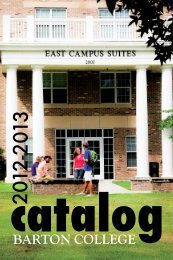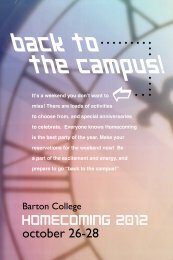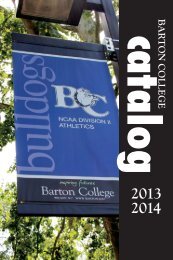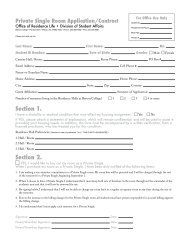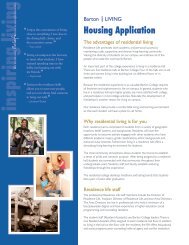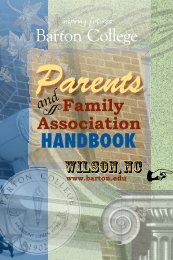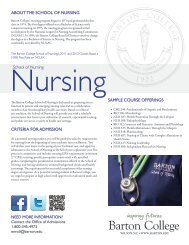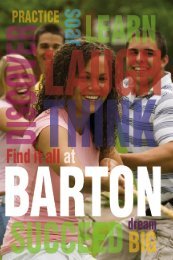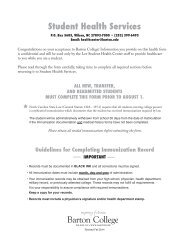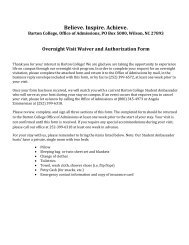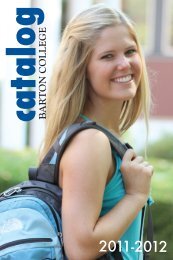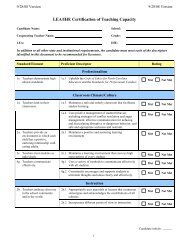Teacher Candidate Evaluation Rubric - Public Schools of North ...
Teacher Candidate Evaluation Rubric - Public Schools of North ...
Teacher Candidate Evaluation Rubric - Public Schools of North ...
Create successful ePaper yourself
Turn your PDF publications into a flip-book with our unique Google optimized e-Paper software.
<strong>North</strong> CarolinaEducator <strong>Evaluation</strong> System<strong>Teacher</strong> <strong>Candidate</strong><strong>Evaluation</strong> <strong>Rubric</strong>
<strong>Teacher</strong> <strong>Candidate</strong> <strong>Evaluation</strong> <strong>Rubric</strong>The following rubric was developed to align with and reflect the <strong>North</strong> Carolina Pr<strong>of</strong>essional TeachingStandards approved by the <strong>North</strong> Carolina State Board <strong>of</strong> Education on June 7, 2007. The rubric alsoparallels the <strong>North</strong> Carolina Inservice <strong>Teacher</strong> <strong>Evaluation</strong> <strong>Rubric</strong> that is used to assess the pr<strong>of</strong>essionalperformance <strong>of</strong> inservice teachers throughout the state. However, the <strong>Teacher</strong> <strong>Candidate</strong> <strong>Evaluation</strong> <strong>Rubric</strong>has been adapted to reflect the specific contexts and opportunities available to teacher candidates throughouttheir programs, and to allow distinctions to be made across each <strong>of</strong> four levels <strong>of</strong> performance on the <strong>North</strong>Carolina Pr<strong>of</strong>essional Teaching Standards.Preservice teacher (candidate) performance should be rated on each element within each Standard ascharacteristic <strong>of</strong> a practitioner at one <strong>of</strong> four levels: Emergent <strong>Candidate</strong>, Developing <strong>Candidate</strong>, Pr<strong>of</strong>icient<strong>Candidate</strong> or Accomplished <strong>Candidate</strong>. These levels are cumulative across the rows <strong>of</strong> the rubric in that a“Pr<strong>of</strong>icient <strong>Candidate</strong>” teacher must exhibit the characteristics encompassed under the “Emergent<strong>Candidate</strong>” and “Developing <strong>Candidate</strong>” levels in addition to those described at the “Pr<strong>of</strong>icient <strong>Candidate</strong>”level. To be recommended for licensure, a candidate must demonstrate pr<strong>of</strong>essional performance at no lessthan the Pr<strong>of</strong>icient <strong>Candidate</strong> level on each element and on each standard.i
Standard 1: <strong>Teacher</strong>s demonstrate leadership1ObservationArtifact1a. <strong>Teacher</strong>s lead in their classrooms. <strong>Teacher</strong>s demonstrate leadership by taking responsibility for the progress <strong>of</strong> all students to ensure that they graduate from highschool, are globally competitive for work and postsecondary education, and are prepared for life in the 21st century. <strong>Teacher</strong>s communicate this vision to their students. Using avariety <strong>of</strong> data sources, they organize, plan, and set goals that meet the needs <strong>of</strong> the individual student and the class. <strong>Teacher</strong>s use various types <strong>of</strong> assessment data during the schoolyear to evaluate student progress and to make adjustments to the teaching and learning process. They establish a safe, orderly environment, and create a culture that empowersstudents to collaborate and become lifelong learners.Emergent <strong>Candidate</strong> Developing <strong>Candidate</strong> Pr<strong>of</strong>icient <strong>Candidate</strong> Accomplished <strong>Candidate</strong>Acknowledges theimportance <strong>of</strong> high schoolgraduation for students.Identifies the types <strong>of</strong> datathat are commonly availableto and used in schools.ANDDemonstrates how teacherscontribute to students’ progresstoward high school graduationby following the <strong>North</strong>Carolina Standard Course <strong>of</strong>Study.Uses data to identify the skillsand abilities <strong>of</strong> students.Describes the characteristicsand importance <strong>of</strong> a safe andorderly classroom environment.Understands positivemanagement <strong>of</strong> studentbehavior, including strategies<strong>of</strong> conflict resolution and angermanagement, effectivecommunication for defusingand deescalating disruptive ordangerous behavior, and safeand appropriate use <strong>of</strong>seclusion and restraint.ANDEvaluates the progress <strong>of</strong> studentstoward high school graduationusing a variety <strong>of</strong> assessment datameasuring goals <strong>of</strong> the <strong>North</strong>Carolina Standard Course <strong>of</strong>Study.Draws on appropriate data todevelop classroom andinstructional plans.Maintains a safe and orderlyclassroom that facilitates studentlearning.Uses positive management <strong>of</strong>student behavior, includingstrategies <strong>of</strong> conflict resolution andanger management, effectivecommunication for defusing anddeescalating disruptive ordangerous behavior, and safe andappropriate seclusion and restraint.ANDTakes responsibility for studentprogress toward high schoolgraduation by aligninginstruction and assessment withthe <strong>North</strong> Carolina StandardCourse <strong>of</strong> Study.Maintains or supports aclassroom culture thatempowers students tocollaborate and becomelifelong learners.Not Demonstrated(Comment Required)Approved by the NC State Board <strong>of</strong> EducationSeptember 11, 2008
2ObservationObservationArtifactArtifact1b. <strong>Teacher</strong>s demonstrate leadership in the school. <strong>Teacher</strong>s work collaboratively with school personnel to create a pr<strong>of</strong>essional learning community. They analyzeand use local, state, and national data to develop goals and strategies in the school improvement plan that enhances student learning and teacher working conditions. <strong>Teacher</strong>sprovide input in determining the school budget and in the selection <strong>of</strong> pr<strong>of</strong>essional development that meets the needs <strong>of</strong> students and their own pr<strong>of</strong>essional growth. They participatein the hiring process and collaborate with their colleagues to mentor and support teachers to improve the effectiveness <strong>of</strong> their departments or grade levels.Not DemonstratedEmergent <strong>Candidate</strong> Developing <strong>Candidate</strong> Pr<strong>of</strong>icient <strong>Candidate</strong> Accomplished <strong>Candidate</strong>(Comment Required)Recognizes opportunitiesfor involvement inpr<strong>of</strong>essional learningactivities.ANDAttends pr<strong>of</strong>essional learningactivities.ANDEngages in collaborative andcollegial pr<strong>of</strong>essional learningactivities.Identifies the characteristics orcritical elements <strong>of</strong> a schoolimprovement plan.Displays the ability to useappropriate data to identify areas<strong>of</strong> need that should be addressed ina school improvement plan.ANDParticipates in pr<strong>of</strong>essionallearning community (PLC)activities.Works with others indeveloping and/orimplementing schoolimprovement activities.1c. <strong>Teacher</strong>s lead the teaching pr<strong>of</strong>ession. <strong>Teacher</strong>s strive to improve the teaching pr<strong>of</strong>ession. They contribute to the establishment <strong>of</strong> positive working relationships inthe school. They actively participate in and advocate for the decision-making structures in education and government that take advantage <strong>of</strong> the expertise <strong>of</strong> teachers. <strong>Teacher</strong>spromote pr<strong>of</strong>essional growth for all educators and collaborate with their colleagues to improve the pr<strong>of</strong>ession.Emergent <strong>Candidate</strong> Developing <strong>Candidate</strong> Pr<strong>of</strong>icient <strong>Candidate</strong> Accomplished <strong>Candidate</strong>Not Demonstrated(Comment Required)ObservationArtifactRecognizes theresponsibility <strong>of</strong> teachers forpr<strong>of</strong>essional improvementand support.ANDRecognizes the need andidentifies opportunities forpr<strong>of</strong>essional growth.ANDParticipates in pr<strong>of</strong>essionaldevelopment and growth activities.Begins to develop pr<strong>of</strong>essionalrelationships and networks.ANDSeeks additional opportunitiesfor pr<strong>of</strong>essional developmentand growth.Extends pr<strong>of</strong>essionalrelationships and networks.1d. <strong>Teacher</strong>s advocate for schools and students. <strong>Teacher</strong>s advocate for positive change in policies and practices affecting student learning. They participate in theimplementation <strong>of</strong> initiatives to improve the education <strong>of</strong> students.Emergent <strong>Candidate</strong> Developing <strong>Candidate</strong> Pr<strong>of</strong>icient <strong>Candidate</strong> Accomplished <strong>Candidate</strong>Not Demonstrated(Comment Required)Demonstrates awareness <strong>of</strong>school practices andpolicies.ANDIdentifies the policies andpractices affecting students’learning.ANDImplements and adheres to policiesand practices positively affectingstudents’ learning.ANDWorks with others to developand/or revise policies andpractices to improve students’learning.Approved by the NC State Board <strong>of</strong> EducationSeptember 11, 2008
ObservationArtifact1e. <strong>Teacher</strong>s demonstrate high ethical standards. <strong>Teacher</strong>s demonstrate ethical principles including honesty, integrity, fair treatment, and respect for others. <strong>Teacher</strong>suphold the Code <strong>of</strong> Ethics for <strong>North</strong> Carolina Educators (effective June 1, 1997) and the Standards for Pr<strong>of</strong>essional Conduct adopted April 1, 1998 (www.ncptsc.org).Emergent <strong>Candidate</strong> Developing <strong>Candidate</strong> Pr<strong>of</strong>icient <strong>Candidate</strong> Accomplished <strong>Candidate</strong>Not Demonstrated(Comment Required)Recognizes the need forethical pr<strong>of</strong>essionalbehavior.ANDArticulates the importance <strong>of</strong>ethical behavior as outlined inthe Code <strong>of</strong> Ethics for <strong>North</strong>Carolina Educators and theStandards for Pr<strong>of</strong>essionalConduct.ANDUpholds the Code <strong>of</strong> Ethics for<strong>North</strong> Carolina Educators and theStandards for Pr<strong>of</strong>essionalConduct.ANDModels the tenets <strong>of</strong> the Code<strong>of</strong> Ethics for <strong>North</strong> CarolinaEducators and the Standardsfor Pr<strong>of</strong>essional Conduct, andencourages others to do thesame.Standard 2: <strong>Teacher</strong>s establish a respectful environment for a diverse population <strong>of</strong> students3ObservationArtifact2a. <strong>Teacher</strong>s provide an environment in which each child has a positive, nurturing relationship with caring adults. <strong>Teacher</strong>s provide anenvironment for student learning that is inviting, respectful, supportive, inclusive, and flexible.Emergent <strong>Candidate</strong> Developing <strong>Candidate</strong> Pr<strong>of</strong>icient <strong>Candidate</strong> Accomplished <strong>Candidate</strong>Not Demonstrated(Comment Required)Articulates the importance<strong>of</strong> appropriate and caringlearning environments forchildren.ANDRecognizes and can explainaspects <strong>of</strong> a respectful andeffective learning environment.ANDMaintains a positive and nurturinglearning environment.ANDEnhances an inviting,respectful, inclusive, flexible,and supportive learningenvironment.ObservationArtifact2b. <strong>Teacher</strong>s embrace diversity in the school community and in the world. <strong>Teacher</strong>s demonstrate their knowledge <strong>of</strong> the history <strong>of</strong> diverse cultures and theirrole in shaping global issues. They actively select materials and develop lessons that counteract stereotypes and incorporate histories and contributions <strong>of</strong> all cultures. <strong>Teacher</strong>srecognize the influence <strong>of</strong> race, ethnicity, gender, religion, and other aspects <strong>of</strong> culture on a student’s development and personality. <strong>Teacher</strong>s strive to understand how a student’sculture and background may influence his or her school performance. <strong>Teacher</strong>s consider and incorporate different points <strong>of</strong> view in their instruction.Not DemonstratedEmergent <strong>Candidate</strong> Developing <strong>Candidate</strong> Pr<strong>of</strong>icient <strong>Candidate</strong> Accomplished <strong>Candidate</strong>(Comment Required)Acknowledges that diversecultures impact the world.Identifies the range andaspects <strong>of</strong> diversity <strong>of</strong>students in the classroom.ANDDisplays knowledge <strong>of</strong> diversecultures, their histories, andtheir roles in shaping globalissues.Acknowledges the influence <strong>of</strong>all aspects <strong>of</strong> diversity onstudents’ development andattitudes.ANDAppropriately uses materials orlessons that counteract stereotypesand acknowledges thecontributions <strong>of</strong> all cultures.Incorporates different points <strong>of</strong>view in instruction.Understands the influence <strong>of</strong>diversity and plans instructionaccordingly.ANDConsistently integratesculturally relevant and/orsensitive materials and ideasthroughout the curriculum.Builds on diversity as an assetin the classroom.Approved by the NC State Board <strong>of</strong> EducationSeptember 11, 2008
ObservationArtifact2c. <strong>Teacher</strong>s treat students as individuals. <strong>Teacher</strong>s maintain high expectations, including graduation from high school, for students <strong>of</strong> all backgrounds. <strong>Teacher</strong>sappreciate the differences and value the contribution <strong>of</strong> each student in the learning environment by building positive, appropriate relationships.Emergent <strong>Candidate</strong> Developing <strong>Candidate</strong> Pr<strong>of</strong>icient <strong>Candidate</strong> Accomplished <strong>Candidate</strong>Not Demonstrated(Comment Required)Articulates the need to treatstudents as individuals.ANDEncourages and valuesindividual studentcontributions, regardless <strong>of</strong>background or ability.ANDMaintains a learning environmentthat conveys high expectations <strong>of</strong>every student.ANDEnhances a learningenvironment that meets theneeds <strong>of</strong> individual students.ObservationArtifact2d. <strong>Teacher</strong>s adapt their teaching for the benefit <strong>of</strong> students with special needs. <strong>Teacher</strong>s collaborate with the range <strong>of</strong> support specialists to help meet thespecial needs <strong>of</strong> all students. Through inclusion and other models <strong>of</strong> effective practice, teachers engage students to ensure that their needs are met.Emergent <strong>Candidate</strong> Developing <strong>Candidate</strong> Pr<strong>of</strong>icient <strong>Candidate</strong> Accomplished <strong>Candidate</strong>Not Demonstrated(Comment Required)4ObservationArtifactRecognizes that studentshave individual learningneeds.ANDUnderstands resources andstrategies that can provideassistance in meeting thespecial learning needs <strong>of</strong>individual students.ANDCooperates with specialists anduses resources to support thespecial learning needs <strong>of</strong> allstudents.Uses research-verified strategies toprovide effective learningactivities for students with specialneeds.ANDCoordinates and collaborateswith the full range <strong>of</strong> supportspecialists and resources tohelp meet the special needs <strong>of</strong>all students.Effectively engages specialneeds students in learningactivities and ensures theirunique learning needs are met.2e. <strong>Teacher</strong>s work collaboratively with the families and significant adults in the lives <strong>of</strong> their students. <strong>Teacher</strong>s recognize that educating children is ashared responsibility involving the school, parents or guardians, and the community. <strong>Teacher</strong>s improve communication and collaboration between the school, the home, and thecommunity in order to promote trust and understanding and build partnerships with all segments <strong>of</strong> the school community. <strong>Teacher</strong>s seek solutions to overcome cultural andeconomic obstacles that may stand in the way <strong>of</strong> effective family and community involvement in the education <strong>of</strong> their students.Emergent <strong>Candidate</strong> Developing <strong>Candidate</strong> Pr<strong>of</strong>icient <strong>Candidate</strong> Accomplished <strong>Candidate</strong>Recognizes factors that candiminish or enhanceinvolvement by parents,guardians, and thecommunity in schools.ANDUnderstands strategies forenhancing communicationbetween home and school andfor engaging parents,guardians, and communitymembers in schools.ANDCommunicates and collaborateswith the home and community forthe benefit <strong>of</strong> students.ANDSeeks and implementssolutions to overcome obstaclesto participation <strong>of</strong> families andcommunities.Not Demonstrated(Comment Required)Approved by the NC State Board <strong>of</strong> EducationSeptember 11, 2008
Standard 3: <strong>Teacher</strong>s know the content they teach5ObservationObservationArtifactArtifact3a. <strong>Teacher</strong>s align their instruction with the <strong>North</strong> Carolina Standard Course <strong>of</strong> Study. In order to enhance the <strong>North</strong> Carolina Standard Course <strong>of</strong> Study,teachers investigate the content standards developed by pr<strong>of</strong>essional organizations in their specialty area. They develop and apply strategies to make the curriculum rigorous andrelevant for all students and provide a balanced curriculum that enhances literacy skills. Elementary teachers have explicit and thorough preparation in literacy instruction. Middleand high school teachers incorporate literacy instruction within the content area or discipline.Not DemonstratedEmergent <strong>Candidate</strong> Developing <strong>Candidate</strong> Pr<strong>of</strong>icient <strong>Candidate</strong> Accomplished <strong>Candidate</strong>(Comment Required)Demonstrates awareness <strong>of</strong>the <strong>North</strong> Carolina StandardCourse <strong>of</strong> Study.Understands the importance<strong>of</strong> literacy instruction acrossall subjects, grades and ages.ANDDemonstrates knowledge <strong>of</strong> the<strong>North</strong> Carolina StandardCourse <strong>of</strong> Study by referencingit in the preparation <strong>of</strong> lessonplans.Integrates literacy instruction inindividual lessons and inparticular subject areas.ANDDevelops and applies lessonsbased on the <strong>North</strong> CarolinaStandard Course <strong>of</strong> Study.Integrates effective literacyinstruction throughout thecurriculum and across contentareas to enhance students’learning.ANDDevelops and applies strategiesreflecting the <strong>North</strong> CarolinaStandard Course <strong>of</strong> Study andstandards developed bypr<strong>of</strong>essional organizations tomake the curriculum balanced,rigorous, and relevant.Evaluates and reflects upon theeffectiveness <strong>of</strong> literacyinstruction within and acrosscontent areas.3b. <strong>Teacher</strong>s know the content appropriate to their teaching specialty. <strong>Teacher</strong>s bring a richness and depth <strong>of</strong> understanding to their classrooms by knowingtheir subjects beyond the content they are expected to teach and by directing students’ natural curiosity into an interest in learning. Elementary teachers have broad knowledge acrossdisciplines. Middle school and high school teachers have depth in one or more specific content areas or disciplines.Emergent <strong>Candidate</strong> Developing <strong>Candidate</strong> Pr<strong>of</strong>icient <strong>Candidate</strong> Accomplished <strong>Candidate</strong>Not Demonstrated(Comment Required)Successfully completesgeneral educationcoursework across therequired range <strong>of</strong>disciplines.ANDDemonstrates a basic level <strong>of</strong>content knowledge in theteaching specialty.ANDDemonstrates an appropriate level<strong>of</strong> content knowledge in theteaching specialty.Encourages students to investigatethe content area to expand theirknowledge and satisfy their naturalcuriosity.ANDDemonstrates extensiveknowledge <strong>of</strong> content in theteaching specialty.Prompts students’ curiosity forlearning beyond the requiredcoursework.Approved by the NC State Board <strong>of</strong> EducationSeptember 11, 2008
6ObservationObservationArtifactArtifact3c. <strong>Teacher</strong>s recognize the interconnectedness <strong>of</strong> content areas/disciplines. <strong>Teacher</strong>s know the links and vertical alignment <strong>of</strong> the grade or subject they teach andthe <strong>North</strong> Carolina Standard Course <strong>of</strong> Study. <strong>Teacher</strong>s understand how the content they teach relates to other disciplines in order to deepen understanding and connect learning forstudents. <strong>Teacher</strong>s promote global awareness and its relevance to subjects they teach.Emergent <strong>Candidate</strong> Developing <strong>Candidate</strong> Pr<strong>of</strong>icient <strong>Candidate</strong> Accomplished <strong>Candidate</strong>Recognizes the importance <strong>of</strong>interdisciplinary learning.Understands the importance <strong>of</strong>global awareness for students.ANDArticulates the links betweengrade/subject and the <strong>North</strong>Carolina Standard Course <strong>of</strong>Study.Displays global awareness.ANDDemonstrates knowledge <strong>of</strong> linksbetween grade/subject and the<strong>North</strong> Carolina Standard Course<strong>of</strong> Study by relating content toother disciplines.Relates global awareness to thesubject.ANDIntegrates the links and thevertical alignment <strong>of</strong> the gradeor subject area and the <strong>North</strong>Carolina Standard Course <strong>of</strong>Study. Effectively and broadlyrelates content to otherdisciplines.Not Demonstrated(Comment Required)Integrates global awarenessactivities throughout lessonplans and classroominstructional practices.3d. <strong>Teacher</strong>s make instruction relevant to students. <strong>Teacher</strong>s incorporate 21st century life skills into their teaching deliberately, strategically, and broadly. These skillsinclude leadership, ethics, accountability, adaptability, personal productivity, personal responsibility, people skills, self-direction, and social responsibility. <strong>Teacher</strong>s help their studentsunderstand the relationship between the <strong>North</strong> Carolina Standard Course <strong>of</strong> Study and 21st century content, which includes global awareness; financial, economic, business andentrepreneurial literacy; civic literacy; and health awareness.Emergent <strong>Candidate</strong> Developing <strong>Candidate</strong> Pr<strong>of</strong>icient <strong>Candidate</strong> Accomplished <strong>Candidate</strong>Not Demonstrated(Comment Required)Recognizes the relationshipbetween the <strong>North</strong> CarolinaStandard Course <strong>of</strong> Study andlife in the 21st century.Identifies relationships betweenthe <strong>North</strong> Carolina StandardCourse <strong>of</strong> Study and life in the21st century.Integrates 21st century skills andcontent in instruction.Consistently integrates 21stcentury skills and contentthroughout classroominstruction and assessment.Identifies 21 st century skills andcontent as specified in theFramework for 21 st CenturyLearning and Critical Elementsfor 21 st Century Skills.ANDDemonstrates understanding <strong>of</strong>21 st century skills and contentas specified in the Frameworkfor 21 st Century Learning andCritical Elements for 21 stCentury Skills.ANDANDApproved by the NC State Board <strong>of</strong> EducationSeptember 11, 2008
Standard 4: <strong>Teacher</strong>s facilitate learning for their studentsObservationArtifact4a. <strong>Teacher</strong>s know the ways in which learning takes place, and they know the appropriate levels <strong>of</strong> intellectual, physical, social, and emotionaldevelopment <strong>of</strong> their students. <strong>Teacher</strong>s know how students think and learn. <strong>Teacher</strong>s understand the influences that affect individual student learning (development, culture,language pr<strong>of</strong>iciency, etc.) and differentiate their instruction accordingly. <strong>Teacher</strong>s keep abreast <strong>of</strong> evolving research about student learning. They adapt resources to address thestrengths and weaknesses <strong>of</strong> their students.Not DemonstratedEmergent <strong>Candidate</strong> Developing <strong>Candidate</strong> Pr<strong>of</strong>icient <strong>Candidate</strong> Accomplished <strong>Candidate</strong>(Comment Required)Understands the developmentallevels <strong>of</strong> students.Demonstrates awareness <strong>of</strong> theinfluence <strong>of</strong> developmentallevels on students’ learning.Identifies developmental levels <strong>of</strong>individual students and plansinstruction accordingly.Appropriately differentiatesinstruction.7ObservationObservationArtifactArtifactANDDemonstrates an understanding<strong>of</strong> methods for differentiatinginstruction to accommodatedevelopmental differences instudents.ANDAssesses and uses resourcesneeded to address strengths andweaknesses <strong>of</strong> students.4b. <strong>Teacher</strong>s plan instruction appropriate for their students. <strong>Teacher</strong>s collaborate with their colleagues and use a variety <strong>of</strong> data sources for shortand long range planning based on the <strong>North</strong> Carolina Standard Course <strong>of</strong> Study. These plans reflect an understanding <strong>of</strong> how students learn. <strong>Teacher</strong>s engage studentsin the learning process. They understand that instructional plans must be consistently monitored and modified to enhance learning. <strong>Teacher</strong>s make the curriculum responsive to culturaldifferences and individual learning needs.Emergent <strong>Candidate</strong> Developing <strong>Candidate</strong> Pr<strong>of</strong>icient <strong>Candidate</strong> Accomplished <strong>Candidate</strong>Recognizes data sourcesimportant to planninginstruction.ANDUses a variety <strong>of</strong> data for shortandlong-range planning <strong>of</strong>instruction.Monitors and modifiesinstructional plans to enhancestudent learning.ANDCollaborates with colleagues tomonitor student performance andmake instruction responsive tocultural differences and individuallearning needs.ANDANDWorks collaboratively withother school staff to develop ormaintain a culturally anddevelopmentally supportiveschool environment.Not Demonstrated(Comment Required)4c. <strong>Teacher</strong>s use a variety <strong>of</strong> instructional methods. <strong>Teacher</strong>s choose the methods and techniques that are most effective in meeting the needs <strong>of</strong> their students as theystrive to eliminate achievement gaps. <strong>Teacher</strong>s employ a wide range <strong>of</strong> techniques including information and communication technology, learning styles, and differentiated instruction.Emergent <strong>Candidate</strong> Developing <strong>Candidate</strong> Pr<strong>of</strong>icient <strong>Candidate</strong> Accomplished <strong>Candidate</strong>Not Demonstrated(Comment Required)Understands a range <strong>of</strong> methodsand materials that can beapplied in the classroom.ANDDemonstrates awareness <strong>of</strong> thevariety <strong>of</strong> methods andmaterials necessary to meet theneeds <strong>of</strong> all students.ANDUses a variety <strong>of</strong> appropriatemethods and materials to meet theneeds <strong>of</strong> all students.ANDConsistently enables thesuccess <strong>of</strong> all students throughthe selection and use <strong>of</strong>appropriate methods andmaterials.Approved by the NC State Board <strong>of</strong> EducationSeptember 11, 2008
ObservationArtifact4d. <strong>Teacher</strong>s integrate and utilize technology in their instruction. <strong>Teacher</strong>s know when and how to use technology to maximize student learning. <strong>Teacher</strong>s helpstudents use technology to learn content, think critically, solve problems, discern reliability, use information, communicate, innovate, and collaborate.Emergent <strong>Candidate</strong> Developing <strong>Candidate</strong> Pr<strong>of</strong>icient <strong>Candidate</strong> Accomplished <strong>Candidate</strong>Not Demonstrated(Comment Required)Demonstrates knowledge <strong>of</strong>methods for utilizingtechnology in instruction.ANDAssesses effective types <strong>of</strong>technology to use forinstruction.ANDIntegrates technology withinstruction to maximize students’learning.ANDEngages students in higherlevel thinking through theintegration <strong>of</strong> technology.8ObservationArtifact4e. <strong>Teacher</strong>s help students develop critical-thinking and problem-solving skills. <strong>Teacher</strong>s encourage students to ask questions; think creatively; develop and testinnovative ideas; synthesize knowledge and draw conclusions. They help students exercise and communicate sound reasoning; understand connections; make complex choices; andframe, analyze, and solve problems.Emergent <strong>Candidate</strong> Developing <strong>Candidate</strong> Pr<strong>of</strong>icient <strong>Candidate</strong> Accomplished <strong>Candidate</strong>Demonstrates an understanding<strong>of</strong> the importance <strong>of</strong> developingstudents’ critical-thinking andproblem-solving skills.ANDDemonstrates knowledge <strong>of</strong>processes needed to supportstudents in acquiring criticalthinkingand problem-solvingskills.ANDIntegrates specific instruction thathelps students develop the abilityto apply processes and strategiesfor critical thinking and problemsolving.ANDCreates or maintains instructionthat consistently engagesstudents in the processes <strong>of</strong>critical thinking and problemsolving in meaningful contexts.Not Demonstrated(Comment Required)ObservationArtifact4f. <strong>Teacher</strong>s help students work in teams and develop leadership qualities. <strong>Teacher</strong>s teach the importance <strong>of</strong> cooperation and collaboration. They organizelearning teams in order to help students define roles, strengthen social ties, improve communication and collaborative skills, interact with people from different cultures andbackgrounds, and develop leadership qualities.Not DemonstratedEmergent <strong>Candidate</strong> Developing <strong>Candidate</strong> Pr<strong>of</strong>icient <strong>Candidate</strong> Accomplished <strong>Candidate</strong>(Comment Required)Recognizes the need toencourage the development <strong>of</strong>cooperation, collaboration, andstudent leadership.ANDDemonstrates awareness <strong>of</strong>multiple approaches orstrategies for developing andsupporting student learningteams.ANDOrganizes student learning teamsfor the purpose <strong>of</strong> developingcooperation, collaboration, andstudent leadership.ANDEncourages students to createand manage learning teams.Approved by the NC State Board <strong>of</strong> EducationSeptember 11, 2008
ObservationObservationArtifactArtifact4g. <strong>Teacher</strong>s communicate effectively. <strong>Teacher</strong>s communicate in ways that are clearly understood by their students. They are perceptive listeners and are able tocommunicate with students in a variety <strong>of</strong> ways even when language is a barrier. <strong>Teacher</strong>s help students articulate thoughts and ideas clearly and effectively.Emergent <strong>Candidate</strong> Developing <strong>Candidate</strong> Pr<strong>of</strong>icient <strong>Candidate</strong> Accomplished <strong>Candidate</strong>Communicates effectively bothorally and in writing.Recognizes a variety <strong>of</strong>methods for communicatingeffectively with students.ANDDemonstrates the ability tocommunicate effectively withstudents.Provides opportunities forstudents to articulate thoughtsand ideas.ANDUses a variety <strong>of</strong> methods tocommunicate effectively with allstudents.Consistently encourages andsupports students to articulatethoughts and ideas clearly andeffectively.ANDEstablishes classroom practicesthat encourage all students todevelop effectivecommunication skills.Not Demonstrated(Comment Required)4h. <strong>Teacher</strong>s use a variety <strong>of</strong> methods to assess what each student has learned. <strong>Teacher</strong>s use multiple indicators, including formative and summative assessments,to evaluate student progress and growth as they strive to eliminate achievement gaps. <strong>Teacher</strong>s provide opportunities, methods, feedback, and tools for students to assess themselves andeach other. <strong>Teacher</strong>s use 21st Century assessment systems to inform instruction and demonstrate evidence <strong>of</strong> students’ 21st century knowledge, skills, performance, and dispositions.Emergent <strong>Candidate</strong> Developing <strong>Candidate</strong> Pr<strong>of</strong>icient <strong>Candidate</strong> Accomplished <strong>Candidate</strong>Not Demonstrated(Comment Required)9Demonstrates awareness <strong>of</strong>multiple indicators or measures<strong>of</strong> student progress.ANDInterprets data on studentprogress accurately and candraw appropriate conclusions.ANDUses multiple indicators, bothformative and summative, tomonitor and evaluate students’progress and to inform instruction.Provides evidence that studentsattain 21st century knowledge,skills and dispositions.ANDUses information gained fromassessment activities toimprove teaching practice andstudents’ learning.Provides opportunities forstudents to assess themselvesand others.Approved by the NC State Board <strong>of</strong> EducationSeptember 11, 2008
Standard 5: <strong>Teacher</strong>s reflect on their practiceObservationArtifact5a. <strong>Teacher</strong>s analyze student learning. <strong>Teacher</strong>s think systematically and critically about student learning in their classrooms and schools: Why learning happens and whatcan be done to improve achievement. <strong>Teacher</strong>s collect and analyze student performance data to improve school and classroom effectiveness. They adapt their practice based on researchand data to best meet the needs <strong>of</strong> students.Emergent <strong>Candidate</strong> Developing <strong>Candidate</strong> Pr<strong>of</strong>icient <strong>Candidate</strong> Accomplished <strong>Candidate</strong>Recognizes multiple sources <strong>of</strong>information on students’learning and performance.ANDIdentifies data sources toimprove students’ learning.ANDUses data to provide ideas aboutwhat can be done to improvestudents’ learning.ANDBased upon data, selects ordevelops instructionalapproaches that areintentionally tailored tostudents’ learning needs.Not Demonstrated(Comment Required)ObservationArtifact5b. <strong>Teacher</strong>s link pr<strong>of</strong>essional growth to their pr<strong>of</strong>essional goals. <strong>Teacher</strong>s participate in continued, high quality pr<strong>of</strong>essional development that reflects a global view<strong>of</strong> educational practices; includes 21st century skills and knowledge; aligns with the State Board <strong>of</strong> Education priorities; and meets the needs <strong>of</strong> students and their own pr<strong>of</strong>essionalgrowth.Emergent <strong>Candidate</strong> Developing <strong>Candidate</strong> Pr<strong>of</strong>icient <strong>Candidate</strong> Accomplished <strong>Candidate</strong>Not Demonstrated(Comment Required)10Acknowledges the importance<strong>of</strong> ongoing pr<strong>of</strong>essionaldevelopment.ANDAttends required or expectedactivities for pr<strong>of</strong>essionalgrowth.ANDParticipates in recommendedactivities for pr<strong>of</strong>essional learningand development.ANDSeeks out and engages inopportunities to expandpr<strong>of</strong>essional knowledge andbuild pr<strong>of</strong>essional skills.ObservationArtifact5c. <strong>Teacher</strong>s function effectively in a complex, dynamic environment. Understanding that change is constant, teachers actively investigate and consider new ideasthat improve teaching and learning. They adapt their practice based on research and data to best meet the needs <strong>of</strong> their students.Emergent <strong>Candidate</strong> Developing <strong>Candidate</strong> Pr<strong>of</strong>icient <strong>Candidate</strong> Accomplished <strong>Candidate</strong>Not Demonstrated(Comment Required)Acknowledges the importance<strong>of</strong> using research-verifiedapproaches to teaching andlearning.ANDDemonstrates knowledge <strong>of</strong>current research-verifiedapproaches to teaching andlearning.ANDUses a variety <strong>of</strong> research-verifiedapproaches to improve teachingand learning.ANDInvestigates and implementsinnovative, research-verifiedapproaches to improve teachingand learning.Approved by the NC State Board <strong>of</strong> EducationSeptember 11, 2008
Glossary <strong>of</strong> TermsAccomplished <strong>Candidate</strong>: The fourth <strong>of</strong> four performance levels used to rate a candidate’s pr<strong>of</strong>iciency onelements <strong>of</strong> the standards. Reflects only those candidates who possess and demonstrate trulyexemplary understanding, mastery, and consistent integration <strong>of</strong> relevant concepts and skills in theirpr<strong>of</strong>essional practice. Such candidates regularly engage in activities that intentionally and proactivelyencourage the pr<strong>of</strong>essional growth <strong>of</strong> colleagues, continually evaluate their own performance, andactively seek ways to improve their performance.Artifact: A product used to demonstrate a teacher candidate’s performance or pr<strong>of</strong>iciency.Code <strong>of</strong> Ethics for <strong>North</strong> Carolina Educators: The standards <strong>of</strong> pr<strong>of</strong>essional conduct required <strong>of</strong> educatorsand adopted by the <strong>North</strong> Carolina State Board <strong>of</strong> Education, 6/5/97 (Appendix E).Developing <strong>Candidate</strong>: The second <strong>of</strong> four performance levels used to rate a candidate’s pr<strong>of</strong>iciency onelements <strong>of</strong> the standards. Reflects a candidate with the skills and knowledge <strong>of</strong> a student who hassuccessfully completed some teacher education coursework. Such candidates have mastered importantconcepts and demonstrated the ability to apply these to concrete problems, but in contexts <strong>of</strong> limitedcomplexity (e.g., case study analysis, simulations, early field experiences, etc.).Diversity: Differences in the characteristics <strong>of</strong> people, places or things (e.g., age, race, ethnicity, culture,gender, education, learning styles, religion, and any other ways in which differences occur).Electronic Evidence: The artifacts or other materials that are used by the institution to support licensurecandidates’ performance ratings and that are accessible by the <strong>North</strong> Carolina State Board <strong>of</strong>Education for programmatic review.Emerging <strong>Candidate</strong>: The first <strong>of</strong> four performance levels used to rate a candidate’s pr<strong>of</strong>iciency onelements <strong>of</strong> the standards. Reflects a candidate who is a new student to the field <strong>of</strong> education. Suchcandidates are engaged in their baccalaureate, and perhaps teacher education, coursework. However,the Emerging <strong>Candidate</strong> possesses only a limited or superficial knowledge and awareness <strong>of</strong> conceptsassociated with educational concepts.Evaluator: The person or persons designated by an institution as responsible for overseeing and completingthe summative evaluation <strong>of</strong> licensure candidate’s performance.Formative: <strong>Evaluation</strong> conducted during a program that produces information used primarily to makemodifications and improvement; may be conducted as <strong>of</strong>ten as necessary.Literacy: (i) Age-appropriate knowledge (reading, writing, comprehension, skills) in any particular contentarea or field; (ii) ability to understand, communicate, and apply principles associated with 21 st CenturySkills (e.g., financial, economic, business, and entrepreneurial literacy, civic literacy, information andmedia literacy, and ICT literacy). See Framework for 21 st Century Learning and Critical Elements forCreating 21 st Century Skills.<strong>North</strong> Carolina Standard Course <strong>of</strong> Study: The materials that establish competencies for each grade andhigh school course to ensure rigorous student academic performance standards that are uniform acrossthe state. Where this document is referenced in this manual and in the rubric, other state-approvedstandards (e.g., <strong>North</strong> Carolina Early Learning Standards, <strong>North</strong> Carolina Standards for Career andVocational Technology, etc.) also apply.Performance Descriptor: Discrete statements <strong>of</strong> specific competency that collectively reflect a performancelevel in the rubric.Performance Element: A paragraph that describes in detail one constituent aspect <strong>of</strong> a performancestandard. The rubric contains twenty-five performance elements.Performance Level: The label (e.g., Emergent <strong>Candidate</strong>, Developing <strong>Candidate</strong>, Pr<strong>of</strong>icient <strong>Candidate</strong>, andAccomplished <strong>Candidate</strong>) applied to each <strong>of</strong> four categories used to rate a teacher candidate’s overallperformance for a performance element in the rubric.11
Performance Standard: A statement reflecting a domain <strong>of</strong> pr<strong>of</strong>essional practice against which educatorperformance is judged. The rubric contains five separate performance standards.Pr<strong>of</strong>essional Learning Community (PLC): Describes a collegial group <strong>of</strong> administrators and school staffwho are united in their commitment to student learning and who work in an environment characterizedby mutual cooperation, personal growth, and a synergy <strong>of</strong> efforts. In PLCs, school and districtadministrators share power and authority by inviting staff input in decision making and by a sustainedcommitment to learning among staff about solutions to address students' needs.Pr<strong>of</strong>icient <strong>Candidate</strong>: The third <strong>of</strong> four performance levels used to rate a candidate’s pr<strong>of</strong>iciency onelements <strong>of</strong> the standards. Reflects a candidate who has mastered important concepts anddemonstrated the ability to apply these concepts consistently in real-world contexts (e.g., internships).Such candidates have the knowledge and skills to perform effectively. This is the minimumperformance level required to be recommended for licensure.<strong>Rubric</strong>: The instrument comprised <strong>of</strong> standards, elements and descriptors used to evaluate preservice schoolexecutive performance against the <strong>North</strong> Carolina Pr<strong>of</strong>essional Teaching Standards.Special needs: Students with diverse abilities and disabilities who are not achieving optimal educationoutcomes. This may include students with identified disabilities, students from culturally andlinguistically diverse backgrounds, and students who are academically and intellectually gifted.Summative: <strong>Evaluation</strong> conducted at the end <strong>of</strong> a program that leads to a concluding judgment aboutperformance.Works with others: Phrase used in some descriptors that indicates that a candidate has completed a task incollaboration with additional individuals such as a cooperating teacher and/or program advisor.12



